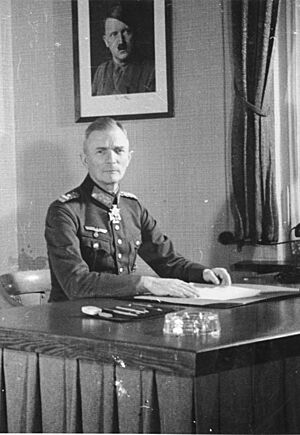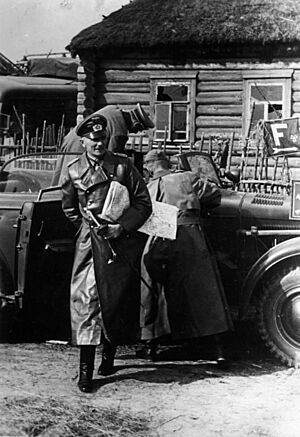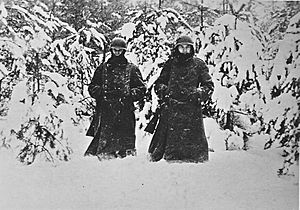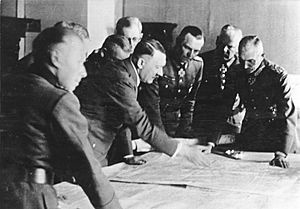Fedor von Bock facts for kids
Quick facts for kids
Fedor von Bock
|
|
|---|---|
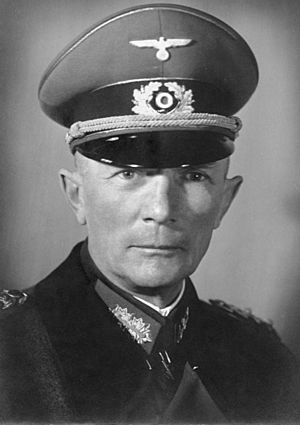
Fedor von Bock as a General in 1939
|
|
| Birth name | Moritz Albrecht Franz Friedrich Fedor von Bock |
| Nickname(s) |
|
| Born | 3 December 1880 Cüstrin, Prussia, German Empire (now Kostrzyn nad Odrą, Poland) |
| Died | 4 May 1945 (aged 64) Oldenburg in Holstein, Nazi Germany |
| Buried |
Friedhof Lensahn
|
| Allegiance |
|
| Service/ |
|
| Years of service | 1898 – 1942 |
| Rank | Generalfeldmarschall |
| Commands held | Reichswehr:
|
| Battles/wars |
See battles
|
| Awards | |
| Spouse(s) |
|
| Children | 1 |
| Relations |
|
| Signature |  |
Fedor von Bock (born December 3, 1880 – died May 4, 1945) was a German field marshal who served in the German Army during World War II. He led important army groups during major invasions.
Bock was the commander of Army Group North during the invasion of Poland in 1939. He then commanded Army Group B during the invasion of France in 1940. Later, he led Army Group Center during the attack on the Soviet Union in 1941. His last command was Army Group South in 1942.
Bock led Operation Typhoon, which was an attempt to capture Moscow in late 1941. The German attack slowed down due to strong Soviet resistance and heavy rain and mud. The Soviet army then pushed the Germans back. Because of this, Adolf Hitler removed Bock from his command.
Bock was loyal to the idea of a monarchy, a system with a king or queen. He generally stayed out of politics. Hitler allowed Bock to speak his mind because he was successful in battles. Bock, his second wife, and his stepdaughter died on May 4, 1945. Their car was attacked by a New Zealand fighter-bomber while they were traveling towards Hamburg.
Contents
Early Life and World War I Service
Fedor von Bock was born in Cüstrin, Germany. This city is now called Kostrzyn and is in Poland. His family had a long history of serving in the Prussian military.
His father, Moritz Albert Karl von Bock, was a military division commander. His mother's brother, Erich von Falkenhayn, was a top German general during World War I. At age eight, Bock went to a military academy in Berlin. This education focused on military training. He became good at languages, math, and history. He spoke French well and knew some English and Russian. From a young age, Bock was very loyal to his country and dedicated to being a soldier.
Bock was a highly motivated officer. He often spoke to new cadets at his old military school. He always told them that the greatest honor for a German soldier was to die for their country. He quickly earned the nickname "Holy Fire of Küstrin."
In 1905, Bock married Mally von Reichenbach. They had one daughter. In 1908, Bock joined the War Academy in Berlin. He later became part of the General Staff. By the time World War I started in 1914, Bock was a captain. He was awarded the Pour le Mérite, which was Germany's highest military honor.
Between the World Wars
After World War I, Bock continued to serve as an officer in the Reichswehr, Germany's army. He moved up in rank. In the 1920s, Bock was part of a secret group. This group helped Germany secretly build up its army. This was done to get around the rules of the Treaty of Versailles, which had limited Germany's military.
In 1935, Adolf Hitler made Bock the commander of the Third Army Group. Bock was one of the officers who kept his position when Hitler reorganized the armed forces. This happened as Germany prepared for World War II. Bock remained loyal to the idea of a monarchy. Hitler reportedly said that "Nobody in the world but Bock can teach soldiers to die." In 1936, Bock married Wilhelmine von Boddien.
Bock led the invasion of Vienna in March 1938. This was part of the Anschluss, when Germany took over Austria. He also commanded the invasion of Czechoslovakia.
World War II Campaigns
Invasion of Poland (1939)
By August 25, 1939, Bock was in charge of Army Group North. This group was preparing to invade Poland. Their goal was to destroy Polish forces north of the Vistula River. Army Group North included the 3rd Army and the 4th Army. They attacked from East Prussia and across the Polish Corridor.
On September 10, Bock ordered his troops to burn Polish villages. This was to happen if soldiers were shot at from a village and the specific house could not be found. By October 26, 1939, 531 towns and villages in Poland had been destroyed. Within five weeks, German and Soviet forces had taken over Poland.
Invasion of France (1940)
After Poland was conquered, Bock was given command of Army Group B on October 12, 1939. This group had nearly 30 divisions, including three tank divisions. Their mission was to advance through the Low Countries (Netherlands, Belgium, Luxembourg). They aimed to trap the northern Allied armies. Army Group B included the 18th and 6th Armies.
In May 1940, while his units were taking over the Netherlands, Bock tried to visit the former German Emperor, Wilhelm II. The Emperor was living in exile in Doorn. However, Bock was not allowed to enter.
Bock also took part in the signing of the armistice with France in June 1940. On July 19, 1940, Bock was promoted to the rank of field marshal. In late August, Army Group B was moved to East Prussia. On September 11, Bock handed over his command in France.
Invasion of the Soviet Union (1941)
On February 2, 1941, Bock met with Hitler. He asked if the Soviet Union could be forced to make peace even if their army was defeated. Hitler told Bock that Germany had enough resources and was determined to fight. For Operation Barbarossa, the invasion of the Soviet Union, Army Group B was renamed Army Group Center on April 1, 1941.
Army Group Center was one of three main army groups for the invasion. It included the 4th and 9th Armies, the 3rd and 2nd Panzer Armies, and air support. To the left of Bock's group was Army Group North. To the right was Army Group South.
The main goal of Army Group Center was to advance towards Moscow. After border battles, the plan was to move towards Minsk and Smolensk. There, they would surround and destroy Soviet armies.
On June 22, 1941, Operation Barbarossa began. Germany invaded the Soviet Union. German forces quickly crossed rivers and bypassed cities. The first day of the invasion was very successful. Soviet resistance was light, and the Germans achieved complete surprise. They made rapid progress along the entire front.
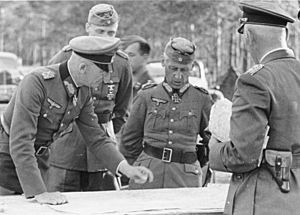
On the second day, Bock crossed the Bug River. He received reports that Soviet resistance was getting stronger. However, Bock's Army Group Center continued to advance quickly.
Bock wanted to bypass Minsk and attack towards Vitebsk to drive directly to Moscow. This plan was first accepted but then overruled by Hitler. Hitler wanted to surround and destroy the large Soviet armies near Minsk first.
Bock and High Command often disagreed on strategy. Bock still wanted to go straight for Moscow. He believed infantry could destroy the bypassed Soviet armies later. He argued that if encirclement was needed, it should be a larger one further east. Hitler disagreed. He insisted that Soviet armies must be destroyed before moving deeper into Russia. Bock was angry, saying they were losing their best chance for success.
He reluctantly ordered his tanks to help destroy the surrounded Soviet forces. On June 30, the 4th and 9th Armies met near Slonim. They trapped thousands of Soviet soldiers. However, many Soviet soldiers escaped. Bock then ordered his troops to prepare for a full advance to the east. This order again caused conflict between Bock and High Command.
On July 3, Bock's forces were again moving eastward. His tanks crossed the Berezina and Duna rivers. This day, his troops covered over 100 kilometers. Four days later, his tanks crossed the Dnieper River. This was the last major obstacle before Smolensk.
The March on Moscow (1941)
On September 9, Army High Command told Bock to plan the attack on Moscow. This attack was code-named Operation Typhoon. It was to start by September 30. Bock oversaw the planning, and High Command approved it.
For Operation Typhoon, Army Group Center was strengthened with more men and vehicles. It had three infantry armies and three tank armies. With almost 1.5 million soldiers, it was larger than when Operation Barbarossa began. Bock spent September inspecting his forces. Once, he flew over Moscow with another general.
On September 29, Bock met with his main commanders. He stressed that Moscow had to be captured by November 7. This was before winter and to match the anniversary of the Russian Revolution. The next day, Operation Typhoon began. Bock estimated his troops would enter Moscow in three to four weeks. However, his forces immediately faced strong Soviet resistance.
German tanks attacked important rail junctions. Other tank armies moved deep into Russian territory. On October 3, German forces captured Orel. This gave them access to a paved highway leading to Moscow, about 180 kilometers away. Bock ordered his troops to push towards Tula. But within hours, High Command reversed this order. They wanted Bock's tanks to attack Bryansk, where Soviet forces were surrounded. Bock argued that the area to Tula was open. Still, he agreed to divert his tanks to Bryansk.
Cold rain soon began to fall. The roads turned into deep mud, making travel very difficult. Only tanks and tracked vehicles could move, but very slowly. Fuel use increased, adding to supply problems.
The weather improved slightly, allowing Bock's forces to close the encirclements around Bryansk and Vyazma. These battles resulted in huge Soviet losses. About 650,000 prisoners were taken. After this, the Soviet armies facing Bock no longer had more soldiers. Bock was one of the few German officers to speak out against the bad treatment of Soviet prisoners of war.
The weather worsened again, turning roads into impassable mud. Since September 30, Bock had lost many men and vehicles. Fuel and ammunition were dangerously low. Despite this, the advance to Moscow continued. Hitler became very impatient. When German units reached Kaluga and Maloyaroslavets, they were within 40 kilometers of Moscow.
As November arrived, the mud froze as temperatures dropped to -28°C (-20°F). The ground hardened, allowing vehicles to move. But the extreme cold caused suffering for German soldiers. Many had no winter clothing. Frostbite became a serious problem, forcing many soldiers to be evacuated.
On November 20, Bock moved his headquarters closer to the front lines. He visited an artillery post and could see Moscow's buildings through his binoculars. Days later, German forces crossed the Moscow-Volga Canal and reached Khimki. But they soon fell back due to Soviet resistance. On November 29, German units reached the western suburbs of Moscow. On December 4, other units reached Kuntsevo, a western suburb. These were the last advances made by Army Group Center under Bock's command.
On December 6, with temperatures at -45°C (-50°F), fresh Russian troops launched a huge counterattack. All along the front near Moscow, German troops retreated. They destroyed equipment they could not save. Days later, High Command ordered all attacks to stop.
By December 13, German forces had retreated more than 80 kilometers from Moscow. On December 18, Bock was removed from his command of Army Group Center. The official reason was health problems. However, many other high-ranking officers were also removed after the failure to capture Moscow.
1942: Battles in the East
Bock was reassigned to lead Army Group South on January 20, 1942. This happened after the death of Field Marshal Walter von Reichenau. In May 1942, Bock commanded the German forces that defeated a Soviet winter attack. This was during the Second Battle of Kharkov.
On June 28, 1942, Bock's forces broke through the Russian front near Kursk. Three armies, including 11 tank divisions, spread out towards Voronezh and the Don River. Hitler was not happy with Bock's plan to delay the push towards Stalingrad. On July 7, Hitler divided Army Group South into two groups: Army Group A and Army Group B. Hitler then replaced Bock as commander of Army Group B on July 17. Bock never held a senior command position again.
Death in 1945
Bock was injured on May 3, 1945. His car was attacked by a British fighter plane. His wife, stepdaughter, and a friend were killed. Bock was the only survivor of the attack. He died from his injuries the next day, May 4, 1945. He was buried in a cemetery in Lensahn.
Awards and Honors
Fedor von Bock received many awards for his military service, including:
- Iron Cross of 1914 (2nd and 1st class)
- Knight's Cross of the Royal House Order of Hohenzollern with Swords
- Pour le Mérite (April 1, 1918)
- Wehrmacht Long Service Award
- Anschluss Medal
- Sudetenland Medal
- Clasp to the Iron Cross, 1st and 2nd class
- Grand Cross of the Order of the Crown of Italy
- Order of Michael the Brave (Romania)
- Grand Cross of the Order of Merit of the Kingdom of Hungary with Swords
- Knight's Cross of the Iron Cross (September 30, 1939)
See also
 In Spanish: Fedor von Bock para niños
In Spanish: Fedor von Bock para niños
- Corruption within the Wehrmacht


